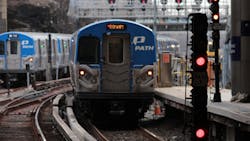PANYNJ details "game changing" PATH Improvement Plan
The Port Authority of New York and New Jersey (PANYNJ) provided details of its PATH Improvement Plan, which will add capacity across the PATH system by 2022, as well as other improvements during the next three years.
PANYNJ says the plan, which also includes a delay reduction initiative, a new fare payment system and a set of customer service initiatives, will be a game-change for the PATH system.
“The PATH Improvement Plan is a comprehensive and forward-thinking approach to fixing the biggest problems facing PATH,” said Port Authority Chairman Kevin O’Toole. “By adding cars and trains, hitting back at the root cause of delays and focusing on the customer experience, PATH will make monumental changes that affect the lives of the nearly 300,000 customers who rely on PATH each day.”
Add capacity
“We want this plan to be game-changing. Increasing the carrying capacity of a legacy rail system by 20-40 percent in a three-year period is almost unheard of, but PATH is making that commitment," said Executive Director Rick Cotton.
PATH has already begun work to add two more rush hour train sets on the Newark-WTC and Journal Square-33rd St lines, optimizing between-train headways of 3-4 minutes on the busiest lines at the busiest times of day. This shift will increase capacity by 10 percent on these lines by September 2019.
By 2022, PATH anticipates an additional 20 percent increase in capacity on the Journal Square-33rd St, Hoboken-WTC, and Hoboken-33rd St lines and a 40 percent increase in Newark-WTC capacity thanks to a plan to accommodate nine cars on all Newark-WTC line trains and a new signal system which will enable trains to run more frequently.
PANYNJ says the capacity increases rely on more than $1 billion dollars in capital investment, including the on-going $750 million investment in a new signal system that enables PATH to run more trains per hour. In 2017, PATH invested $215.7 million in 72 new train cars to add to the existing fleet of 350 cars; the first of the new cars will be put in service beginning in 2021. To accommodate longer trains, PATH has proposed significant improvements at the Grove Street Station, with a planned investment of $80 million to tear down existing walls and extend the existing platform. These station modifications will enable nine-car trains on the Newark to WTC line. Station modifications are also planned for Exchange Place Station to open additional corridors for emergency exits.
Reduce delays
"We also recognize that the PATH system has been plagued by excessive delays. PATH’s six-point delay reduction program tackles this challenge head-on, with a commitment to deliver substantial and measurable improvements. We owe PATH customers improved service, and this plan commits to deliver that improvement,” said Cotton.
The initiative will address six key causes of delay: 1) track conditions; 2) switch failures; 3) car equipment failures 4) signal equipment issues; 5) sick passengers and 6) unattended bags.
PATH also notes that improvements addressing the six areas will be implemented within the next 30 months. PATH will development improvement metrics that it will provide and publish in quarterly updates beginning in September.
Enhance customer experience
The plan calls for PATH to implement a new fare payment system by 2022 that is integrated with the Metropolitan Transportation Authority's new OMNY system. PATH explains the new system and additional efforts to improve in-station, on-train and online alerts and announcements to provide more information in a timely and transparent way, as well as address platform crowding will improve riders’ experience at each part of their journey.
PATH will commit an additional $50 million to delay reduction and customer service initiatives.
"PATH is committed to increasing capacity and meeting the needs of our growing ridership,” said Director of PATH Clarelle DeGraffe. “This plan addresses some of our PATH riders’ biggest concerns, especially with the attention to platform safety, better communication and a user-friendly fare payment system, while ensuring that we intensify the repair and maintenance of our existing system.”
About the Author

Mischa Wanek-Libman
Group Editorial Director
Mischa Wanek-Libman is director of communications with Transdev North America. She has more than 20 years of experience working in the transportation industry covering construction projects, engineering challenges, transit and rail operations and best practices.
Wanek-Libman has held top editorial positions at freight rail and public transportation business-to-business publications including as editor-in-chief and editorial director of Mass Transit from 2018-2024. She has been recognized for editorial excellence through her individual work, as well as for collaborative content.
She is an active member of the American Public Transportation Association's Marketing and Communications Committee and served 14 years as a Board Observer on the National Railroad Construction and Maintenance Association (NRC) Board of Directors.
She is a graduate of Drake University in Des Moines, Iowa, where she earned a Bachelor of Arts degree in Journalism and Mass Communication.
